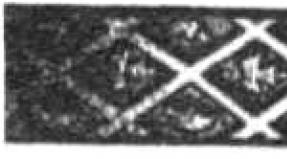The difference between sterilization and castration. Castration is a nightmare for males. Description of expediency and a few words about sterilization. Possible negative consequences after sterilization
which is "better" to choose
Sooner or later, owners of domestic cats begin to think about castration / sterilization of their pets, because in this way they not only save their pets from more problems, but even prolong their life ...
True, a good proportion of cat lovers often erroneously interpret the above concepts, believing that usually males are castrated, and females are sterilized. But in fact, these processes are in no way related to the gender of animals, but involve various types of surgical intervention, ultimately leading to one result - cats and cats lose their ability to reproduce.
What is the difference?
So, at castration there is a complete removal of the sex glands from the body of the animal (in males - the testes, and in females - the ovaries), as a result of which the pet is provided with complete sexual rest throughout the rest of his life. After the operation, the animal will not have any desires and needs, as well as the opportunity to conduct full sexual activity.
And here sterilization, in turn, is rarely used in veterinary medicine for small pets, as it consists in ligating (that is, tying or soldering) the spermatic cords in cats and the oviducts in cats. After such an intervention, animals lose their ability to reproduce, while maintaining sexual activity, since sex hormones continue to be synthesized in their gonads. So it turns out that from the point of view of the health of the animal and the convenience of the life of the household, the sterilization of cats and cats does not make sense at all, because all the nuances of their sexual behavior remain unchanged (increased activity, screams, aggressiveness, etc., etc.) .
Technically, the operation to sterilize domestic cats is quite possible, but it is usually used for medical reasons in the treatment of some diseases.
Training
As for the castration procedure, you need to thoroughly prepare for it:
- firstly, the pet must be hungry (that is, do not eat food for at least 10 hours before the operation);
- secondly, it is best to conduct a preliminary study of the function of the cardiovascular system (especially in animals aged or with any pathologies) in order to minimize all kinds of risks.
Castration of a cat
The surgical intervention itself in cats in this case is carried out as follows: to begin with, anesthesia is injected into the animal, the hair on the scrotum is shaved off and the skin is treated with special means, after which a small incision is made to extract the testicles, and then this very incision is sutured. Typically, such an operation takes no more than 15 minutes, and postoperative sutures do not require any processing or removal.
Castration of a cat
In cats, the entire process of castration is more complicated, since the operation in this case is abdominal, that is, the uterus and ovaries are removed through a deep incision in the groin or abdomen. Surgical manipulations last 30-40 minutes, after which the wound is sutured, and the animal is dressed in a special blanket or collar that prevents the seam from licking and combing.
It is worth noting that females can be castrated not only in the standard way, but also endoscopically - when several small incisions are made on the abdominal wall, through which endoscopic instruments and a camera with an illuminator are inserted. The surgeon controls all his actions by means of a display showing the image of the operation. But such an operation, of course, will cost more.
Recovery after surgery depends on the individual characteristics of the organism of a particular animal, which can take a different time. As a rule, after anesthesia, cats and cats leave after 2-4 hours, and fully recover after about one day.
They are in no way related to the sex of the animal and imply various types of surgical intervention aimed at preventing unwanted reproduction of animals. Castrated, as well as sterilized, can be cats and cats, males and females: in both cases, they lose their ability to reproduce.
Sterilization (vasectomy)- a surgical operation, the purpose of which is to create a barrier to the movement of cells involved in conception. In female animals, the fallopian tubes are tied up (while the egg cannot get from the ovaries to the uterus), and in cats and males, the spermatic cords are tied up, which prevents the release of spermatozoa. During surgery, the genitals are not affected and continue to function normally. Since the hormonal background is not disturbed, all instincts and the ability to mate are fully preserved in sterilized cats and dogs, but pregnancy, for obvious reasons, does not occur.
Castration (ovariohysterectomy)- removal of the organs of the reproductive system: uterus and ovaries (in cats and bitches) and testicles (in cats and males). A variation of this operation is oophorectomy - removal of the ovaries while preserving the uterus. This practice is becoming less and less common: due to the high risk of complications and the development of cancer, the uterus is removed along with the ovaries.
Spay or Neuter: That is the Question
hosts sterilized animals note that after the operation, the behavior of pets practically does not change, tk. the level of sex hormones remains at the same level. However, this does not mean that sterilization occurs absolutely without consequences for the animal's body. At certain moments, real hormonal explosions can be observed when the concentrations of hormones approach critical values. Spayed dogs and cats are more prone to stress and diseases of the genitourinary system. Significant changes are also observed in behavior: animals often become aggressive, more difficult to train, often lose weight for no apparent reason. According to statistics, more than half of the animals with oncological pathology of the genital organs were previously sterilized.
Castration is the "gold standard" of veterinary medicine with minimal risk of developing cancer of the uterus, ovaries and testicles. In 90% of cases, castration helps to cope with behavioral problems: aggression, dominance, increased excitability.

It has been proven to increase the life expectancy of neutered cats and dogs by an average of 1-3 years, and with some age-related diseases, castration is the only way to save a pet. Castration completely eliminates the risk of developing purulent inflammatory diseases of the uterus and ovaries, as well as prostatitis in cats. According to doctors, it is better to castrate animals at a young age, since surgical intervention is a serious stress for the body, and recovery after surgery in adulthood is more difficult.
Castration: briefly about the operation
Thanks to modern veterinary preparations, the operation process is completely painless for cats and dogs. At the preparation stage, the veterinarian intravenously injects a drug for general anesthesia, for the duration of which the animal is immersed in a controlled drug sleep. Next, the surgical field is processed: the hair on the scrotum is shaved off, and the skin is treated with special disinfectants. Through two small incisions, the doctor ties up the spermatic cord and removes the testicles. The duration of the operation rarely exceeds 5-7 minutes; postoperative sutures do not require special treatment and, with rare exceptions, are not removed.
In cats and bitches, the castration technique is somewhat more complicated. The operation is abdominal: the uterus and ovaries are removed through a deep incision in the abdomen in the groin area. The duration of the operation is 30-40 minutes, after which the wound is sutured and a collar or a special blanket is put on the animal, which protects the wound from scratching and licking. In recent years, the laparoscopic technique has been increasingly used, making the operation less traumatic.

Castration: arguments "FOR"
The advantages of castration of non-breeding animals are obvious and undeniable:
- increase in the duration of active longevity;
- positive changes in character (compliance, obedience, lack of aggression);
- change in sexual behavior: lack of interest in individuals of the opposite sex;
- exclusion of the risk of developing inflammatory and oncological diseases;
- in females, the incidence of breast cancer is greatly reduced.
Castration or pills?
Veterinarians are unanimous in their opinion: compared to chemical and hormonal agents, surgery is more preferable. Prolonged and, as a rule, uncontrolled use of hormonal drugs is fraught with serious health problems in adulthood.
Castration and urolithiasis
Numerous clinical studies have not revealed a direct relationship between castration and the incidence of KSD. The main risk factor for the development of urolithiasis is overweight, provoked by metabolic disorders. If the castrated animal is fed correctly, following the recommended diet, the likelihood of the formation of stones in the urinary tract is practically absent. Veterinary pharmacies and pet stores offer a wide range of specialized food for neutered cats and dogs.

Castration and character change
With very rare exceptions, the owners of neutered animals note only positive changes: cats and dogs are easier to train, become affectionate and obedient, do not cause problems in the form of territory marks, howling or meowing.
When is the best time to castrate animals?
The ideal age for castration of cats and males is 8-10 months. Early castration is fraught with a lag in physical development. It is advisable to castrate cats and bitches before the first estrus: in this case, the risk of tumor diseases of the mammary glands is practically reduced to zero.
Answers to all questions of interest on the castration of cats and dogs can be obtained at a face-to-face consultation with a veterinarian.
Cat owners know that their pets can be annoying at certain points in their lives. Many people are familiar with the behavior of animals at a time when they, as the people say, "ask for a cat." At this time, the cat becomes simply unbearable, without stopping to emit inviting cries day or night. Since such a situation can arise at almost any time (even when a cat has small kittens), a reasonable question arises: what to do to alleviate the condition of the animal?
Firstly, if the cat has recently brought offspring and is currently a nursing mother, you do not need to let her out, as this usually entails a new pregnancy. Special tools will help eliminate the smell that cats spread during estrus. In addition, there are special drugs aimed at reducing the feline libido. However, they should not be used without appropriate expert advice.
Neutering and castration are special types of surgery, as a result of which the animal is subsequently unable to reproduce.
Not all cat owners decide on such operations. This is understandable, because someone is going to start breeding purebred cats, someone simply considers such measures to be unnatural and unnecessarily cruel.
Nevertheless, and there is a considerable amount of truth in this, sterilization or castration will, to some extent, make life easier for the animal and its owner. As already mentioned, the number of outbred cats should be controlled, and if we take into account the fact that an animal that is not able to satisfy the instincts of reproduction becomes irritable and sick, then the risk of an operation becomes justified.
It is best to perform surgery on a cat aged nine to ten months. You can do this a little earlier, but not at a later age, since in this case the males may still have a territorial instinct. Particular attention should be paid to the animal after the operation. First of all, you need to monitor the feeding of the cat, because during the adaptation period they can eat without stopping, and getting used to this, they will easily gain excess weight. Usually it's more about cats.
And, finally, about which cat can be operated on. She, and this is the most important thing, must be healthy. In advance, before the operation, you should consult a veterinarian about the preparatory procedures and prices for sterilization of cats, which may vary in different veterinary clinics.
If you are NOT going to breed pets

Many owners of cats and cats, purebred or not, are not going to breed them. And there are quite a lot of such "humanists" who are not castrated and do not sterilize their pets. Allegedly, the operation is cruel and inhuman. Myths about castrated cats, by the way, are very, very subject to challenge. Many simply feel sorry for the money, since the operation of “some animal” is not cheap.
If you are not going to breed your pets, then it is better to spend money on castration / sterilization once. Spending money on pills every time a pet asks for a partner, you can lose a lot more money and nerves. Some pets, by hook or by crook, run away to “walk”, and, if you have a cat, they bring offspring. Now compare what is more inhuman: a one-time operation or drowning unnecessary kittens?
Cats from 7 months old can breed, and some can do this up to 4 times a year!
Among the many owners there is an opinion, they say, let the cat experience the joy of motherhood at least once. If the pregnancy and childbirth are successful, then, yes, he will test. And if not? Kittens can be stillborn, die after childbirth a few days later. This is a blow not only to the physical, but also to the mental health of the cat.
Plus, during the so-called “spring” period, both cats and cats can be aggressive, spoil furniture (tear with claws, mark), their health can deteriorate greatly.
Neutered and neutered cats have been observed to live longer and quieter lives.
They are not tormented by hormonal surges, the hunting instinct is not lost, the health of the whole organism as a whole is not disturbed, and most importantly, they become more affectionate. When walking outside (if you regularly walk your pet), pets do not try to run away, they have a reduced risk of catching an infection. Yes, and you will no longer be pissed off by the cries of the poor animal.
Cats do not need regular sex to stay healthy, like humans do. This process in animals is caused by instinct to continue their kind. So, by sterilizing or neutering your pet, you do not deprive him of one of the joys of life. Rather, on the contrary, you improve his life, psycho-emotional and physical health.
Thus, if you have acquired a cat or a cat not for breeding purposes, but for yourself, then you should not skimp on the operation. Neutering and castration is recommended until the pet reaches one year, when the pet finally grows up and forms.
Spaying a cat - what is it?

Neutering of cats and dogs is a simplified name for the removal of the ovaries ( oophorectomy) or removal of the uterus and ovaries ( ovariohysterectomy). In veterinary medicine, sterilization of cats is very common. Many owners subject their pets to this type of surgery.
According to veterinarians, the optimal solution is to simultaneously perform an ovariectomy along with a hysterectomy.
To the list pluses(relative indications) of cat spaying includes:
- the ability to avoid unwanted pregnancy of a cat;
- the ability to avoid behavior that is associated with estrus;
- prevention of development of tumors of mammary glands.
Absolute readings:
- purulent inflammation of the uterus (pyometra);
- tumors of the uterus and ovaries.
Neutering surgery for a cat or dog - a detailed description

It is recommended that the intestines and stomach of the cat be empty during the operation. To do this, a day before the operation, the cat should be given a tablespoon of vaseline oil. This is great as a laxative.
Immediately before the operation itself, a 12-14-hour starvation diet is maintained, and 1 hour before the operation, water is removed from the cat's diet.
It is also recommended to buy two postoperative blankets in advance. It is necessary to complete the hemming of each ribbon of the blanket. This is done so that after the operation the cat does not pull the thread out of the ribbon and swallow it when it licks. Try to try a blanket on a cat even before the operation. The practice of putting on a blanket will not hurt you. You will also learn how the cat reacts to it. In most cases, animals do not favor a blanket and behave very stiffly in it.
The course of the operation itself
Sterilization of cats is carried out under general anesthesia. Anesthesia is administered intravenously or intramuscularly. Remember that cats are anesthetized with their eyes open, which is why a special ointment is applied to the cornea to protect it from drying out. The owner does not need to know all the stages of the operation to sterilize a cat, but it is still desirable to learn the main stages.
Doctors perform an operative access along the white (middle) line of the abdomen. Using this technique, it is possible to remove the tissues of the uterus in all cases, therefore, the risk of further development of pyometra of the uterine stump is excluded.
Removal of the ovaries is one of the most important stages of the operation. All ovarian tissue is removed to avoid estrus in the animal. The uterus is excised completely below the division into two horns (bifurcation).
Caring for a cat after sterilization surgery - features of care
The animal is brought out of anesthesia with the help of special preparations and a dropper. Soon, all reflexes are restored in him, except for coordination of movement. It will become normal only after 24 after the termination of anesthesia. Until this time, it is better to make a warm bedding on the floor, since after amnesia the temperature of the animal drops immediately by 2-3 degrees. You can also cover the cat with a warm blanket or attach a warm heating pad to its back.
Remember that swallowing and bowel movements do not immediately return to normal.
If after the operation the animal has a dry mouth, you can moisten it with water from time to time. After five hours, put a bowl of water for him. Your pet should receive the first portion of food only a day after the operation. It is best to give 1/3 of the usual diet. In the first days after the operation, try to give soft food. It is also possible that the cat's appetite will not be the best for the first few days.
Also, after the operation, the cat is prescribed an injectable antibiotic. Doctors use a prolonged drug. You will have to give two subcutaneous injections yourself. In addition, you will have to treat the stitches on the cat once a day with alcohol.
Usually the sutures are removed on the 10th-12th day after the operation. Before removing them, make sure that the cat is always in a blanket. Change the blanket as soon as it becomes dirty. It is best to buy two blankets at once. This way you can wash them one by one.
Usually, immediately after surgery, the cat's appetite increases and metabolism decreases. This can lead to obesity. Be sure to control your pet's diet.
Castration of cats - what is it

Castration of a cat is a planned operation, as a result of which the testes (sex glands) are surgically removed. In cats, reproductive function stops and the production of male sex hormones stops. Castration can be done effectively at any age, but it is best done when the cat is 9 months old (this is when puberty begins). Usually by this time the cat becomes strong enough and ready for its first mating. Castration at this age will forever save the cat from behavior that is caused by hormones (aggression, screaming, marking its territory, etc.).
The appearance of a small kitten in every family is a joyful event. He is like a small child, and he needs affection and proper care in the same way. In the first months, the kitten is quite harmless - he eats, sleeps and plays with his toys. But literally by seven or eight months, his behavior rarely changes. The kitten begins a period called puberty, it enters the "teenage" age.
Soon the animal will grow up, get stronger and turn into an adult sexually active male - into a cat. Cats tend to mark their territory. They mark the territory with especially caustic and odorous urine, standing in a special way opposite the areas that they are going to mark. At the same time, cats pursue several goals - attracting females and allocating territory as their own. At the same time, such a territory becomes attractive to cats and inaccessible to outside cats.
However, what if this territory is not a tree in the yard or a car wheel, but a favorite sofa or chair?
Cat urine is extremely pungent and odorous. In no way will you be able to “reason” or convince your cat to stop marking. The popular method face in a puddle"will never work - the cat will understand it in his own way -" you can not mark when the owner is at home», « the owner is unhappy that the urine is not caustic enough I", " the owner doesn't want marks on the sofa, he wants marks on the wallpaper».
No sprays and otuchivalki will not help. As a maximum, you will be able to achieve a change in the places that the cat marks, but not the process itself.
So, here main features, which torment every owner and always cause a lot of negative emotions if the cat is not neutered:
- The cat begins to put his marks in all places of the house, as a rule, in the corners and around the perimeter. These tags exude a terribly unpleasant odor that is difficult to remove even with the help of chemicals. The problem of "tagging" arises with absolutely every cat, this is his natural and completely normal behavior. Indeed, in nature, he needs to have his own territory, which he instinctively marks at home.
- The cat begins to scream loudly at night, preventing the owners from falling asleep normally. This is another normal problem - this is how the cat "calls" the cat, which he needs during this period. Sexual desire of a cat, which is not satisfied, and leads to torment and cries of the animal.
- An animal during puberty is in a state of severe stress, which can cause unjustified aggression towards people. He throws himself on his feet, jumps on the owners' bed at night, rushes around the house, scratches and bites.
The solution to all these problems can be castration of the cat.
This is a procedure for the removal of testicles, or testicles, in cats seven months of age or older.
Castration is the simplest and most effective way to get rid of the pungent smell in the apartment, eliminate the aggression of the animal and even prolong the life of the cat. It can be carried out in several ways, including non-surgical and surgical.
Castration of a cat - pros and cons
« What are the risks of castration?” – this is the question that most animal lovers are interested in. We hasten to reassure you, there is no risk, as this is one of the simplest operations that can be compared with tooth extraction. Such an operation is not associated with any vital organs of the animal and takes place without any complications.
Arguments for
Neutering a cat is the best way to keep you comfortable, unless you plan to use the animal as a sire, of course. After the operation, the cats stop marking their territory. However, it is important to remember: if the animal has already mated before, then there is no one hundred percent guarantee that it will stop marking the territory. Also, after the operation, the cat will no longer mark your clothes or shoes (unless, of course, he holds a grudge against you). Also, the animal will be less aggressive and will not scream.
- Neutered cats live longer than their counterparts who have avoided surgery.
- They also remain cheerful and playful until their old age.
- Castration will save your cat from a whole bunch of feline diseases (for example, prostatitis, adenomas of the perianal glands, prostate tumors and a number of other infections). 70% of non-neutered cats suffer from such diseases. Castrated same almost always remain completely healthy.
Arguments against
Temporary stress and small financial costs.
Where is the best place to castrate?
Castration at home
Pros: You won't have to travel anywhere with your cat. You will not waste time on extra trips to the clinic and back. The cat will remain in its usual conditions, there will be no risk of contracting any infection.
Cons: Surgery involves certain risks. Any operation is best carried out in specially adapted conditions. The equipment of the hospital at times reduces these risks. It is important to note that castration of a cat is not an abdominal operation. That is why sterile conditions are not required. The operation involves much less deep and shorter anesthesia than any other surgical intervention. In many ways, this procedure can be carried out at home.
Castration in the clinic
Pros: all the necessary conditions have been created for a safe operation, the doctor is well versed in the environment and fully controls the situation, minimizing the likelihood of postoperative complications. Also, the cost of the procedure in a clinical setting is much lower.
Cons: You will spend time traveling with the cat to the clinic and back.
Castration of cats at home - what you need to know
Why is it better? Why is this service so popular today?
Highly qualified veterinarians, having agreed with you a convenient time for the visit, will come to your home with all the necessary tools and preparations. The operation itself is quite simple and does not take much time. The whole procedure will take no more than 40-60 minutes. Before surgery, you will receive a comprehensive consultation with a veterinarian.
Castration of cats at home is no different from that in the clinic - the operation is extremely simple, takes a little time, and there is no risk of overcooling the animal on the street during the cold season. In addition, transporting a cat to the veterinary clinic is stressful in itself, and stress can negatively affect any animal organism. If dogs are used to walking outside, then traveling with a cat to a veterinary clinic for castration and back is sure to cause stress to one degree or another.
In the case of castration of a cat at home, stress is completely excluded - the pet recovers faster on its territory.
Many cat owners believe that castration, even at home, is inhumane and cruel. This is not true. It is much more humane to castrate a cat once in a lifetime than to make him suffer all his life. An uncastrated animal does not get the desired communication with cats and lives in constant conditions of stress - the owner scolds, there are no cats, "life is not good." How humane it is is up to you. However, any veterinarian will advise you to perform this simple operation.
Castration methods
The non-surgical (medical) method of castration is considered ineffective and Not recommended veterinarians. Giving your cat potent drugs containing the hormone progestogen, you draw irreversible processes in the animal's body and even the growth of tumors. That is why it is recommended to castrate a cat at home surgically.
Exists two options such an operation:
- The first option is a "closed" castration. It involves ligation of the seminiferous tubules and cutting off part of them (from three to five millimeters).
- The "open method" is carried out by removing the testis and resewing its own ligament.
Both types of operations are the simplest in veterinary medicine, so cat owners have nothing to fear. Many owners do not perform the castration procedure out of compassion for the animals, because they will have to experience pain and a difficult condition after general anesthesia. However, veterinarians say that this procedure always goes unnoticed and painless for him. From general anesthesia, the cat departs in less than a day, again turning into your nimble pet. At the same time, no major changes were observed in the behavior of the cats.
Pity for the animal is the only argument that tells the owners not in favor of castration. But it is worth thinking about how the animal is tormented by its own instincts and sexual needs, which in the natural environment must be satisfied eight times a year or more. A single simple operation immediately solves the problem and saves the animal from suffering for life, the cat becomes calmer and develops harmoniously.
How much does it cost to castrate a cat
Moscow clinics will castrate a cat for 1,500 rubles. In Kaliningrad, such a service will cost 800 rubles. The cost includes the following: examination of the cat at the reception, anesthesia, the operation itself, various medications and materials, maintenance and care of the cat after the operation (the animal will have to spend 24 hours in the hospital).
Cat care after surgery
After castration, no special care is required. Only the recovery period is important. The animal will need to recover from the anesthesia. Just surround your favorite fluffy ball with attention and love. If the cat has not recovered enough yet, then do not let him climb high places (chairs or cabinets) so that the animal does not fall.
Diet
Another thing to pay attention to after having a cat spaying operation. You need to follow the proper nutrition of the pet. If this is not done, then obesity and urolithiasis may occur.
- To prevent the latter, exclude fish from the cat's diet.
- Also make sure that substances such as magnesium, calcium and phosphorus in cat food are kept to a minimum.
- To prevent obesity, do not overfeed your cat.
- After surgery, cats increase the efficiency of deposition of adipose tissue, which is why it is vital to reduce the daily portion of the animal.
- Make sure your pet is drinking enough fluids.
- You can also buy special food for neutered cats.
Your pet needs your care, so spare no expense and time.
Summing up
- The operation to castrate a cat is very simple.
- Due to castration, the cat will avoid a number of extremely unpleasant feline diseases.
- After castration, the cat will retain a cheerful and playful mood.
- Castration of animals at home has a psychological and physiological justification for cats that live in a city apartment and do not have the opportunity to follow their natural instincts.
When you visit a clinic or a doctor visits you, a special card is assigned to your cat. That is why it will be much easier for you to get help at the clinic next time. You can make your pet a passport (to take the cat abroad). Also, the cat can receive vaccinations and the opportunity to undergo an examination (medical examination).
If you decide to get a kitten, do not forget the following

It's no secret that many people just do not have a soul in their little fluffy lumps. They give us joy every day. When a kitten starts living in a house, everyone is just happy. However, only six months pass, and serious problems begin. Until recently, a kitten was a small and cute creature, but now it has ceased into an adult cat that makes noise at night and constantly runs away from home in search of cats. You can't go against nature! In this case, we are talking about instincts. It is they who force the animal to mark its territory.
Experienced housewives know how hard it is to remove the cat smell in the apartment or get rid of shoes from it. It is important to note that a city apartment is not a natural habitat for cats. Mother nature has provided something completely different for these animals. Nature requires cats to mate with cats about eight times a year. Hormones are constantly being produced, which have a powerful influence on the behavior of the animal. He marks and defends his territory, makes noise and yells at night - this is absolutely normal for him. The bottom line is that in the natural environment, cats have no barriers to following their instincts. When a cat starts acting like this in your home, your life can get really uncomfortable. That is why it is important to take all the necessary measures in advance - take care of castration of the cat or sterilization of the cat.
To do or not to do?
This question sooner or later confronts every owner of an adult animal. In order not to be tormented by this question, you must first understand what castration is, why it is done and what will change in the life of the animal after the operation.
Castration is the removal of the testicles, in the case of a cat, the removal of the ovaries and by no means complete castration, cutting off "everything".
How does this happen?
It is produced as follows: the animal is given anesthesia (much weaker than for a serious abdominal operation), a small incision is made on the scrotum, through which the testicles are removed. The incision is sutured and outwardly it is not even very clear whether the cat is neutered or not, it is possible to determine the presence / absence of the testicles only by touch.
In cats, there are two options for castration - the traditional one, in the form of an abdominal operation, when a 10 cm incision is made on the abdomen, after the operation a horse collar is put on the cat, and a more modern method based on the principle of vacuum abortion, when a 3-5 cm incision is made on the side, then it is simply sutured and all. Such an operation is easier to bear.
The operation lasts for 15 minutes, the animal leaves anesthesia from 2 to 4 hours, fully recovers in a day.
Why should an animal be castrated?
The fact is that the sexual instinct is one of the strongest in nature. Animals, unlike humans, have sex not for love or attraction, but for the call of nature solely in order to have offspring. Therefore, the very "mechanism" of this instinct is completely physiological - the animal experiences physical discomfort, irritation, which it tries to eliminate as instinct prompts.
The biggest mistake people make is projecting the behavior of an animal onto themselves, identifying actions with human ones. Everything that people do in relation to love and sex, first of all, comes from the head, a person is a thinking being. But animals are driven by bare physiology, natural instinct. A person can decide for himself, let's say, for religious reasons, that he wants to renounce everything "worldly, carnal." An animal cannot act like that, it SHOULD and that's it.
A pet, not finding an outlet for sexual energy, will look for a way to solve this problem in ways that are understandable to him. All those marks and screams that torment the owners of unneutered animals are just a way to tell other cats "I'm HERE !!" Nothing personal, no one takes revenge on the owners in retaliation, no one harms, etc. etc. Even the soiled bed or clothes of the owner does not get out of this logic - the owner will smell of me, go outside and everyone (cats) around will find out that he has a cat, they will follow him and find ME.
The cat will have heat and heat until she becomes pregnant, the cat will desire a cat even more often. Actually, the cat is almost constantly in "combat readiness". Even attempts to bring a cat to a cat will not correct the situation - you will not get as many cats in the district as an adult mature cat needs! I'm not talking about free range at all, it's just barbarism! On the street, cats face a lot of dangers in the form of dogs, scum-flayers, homeless people who catch cats just to eat, cars. There is no place for a domestic cat on the street!!
In addition, the torment of the animal is expressed not only in the inability to satisfy the sexual instinct, but also in the general deterioration of the physical condition. Many owners are familiar with the situation - a fat kitty walked happy with life, as it flowed, it was blown away like a ball and the coat became worse. Cats can stay in this unkempt state for months!
Thus, castration is primarily a help to the animal to get rid of physiological suffering, and only secondarily will the disappearance of the accompanying "charms of life" in the form of marks, ora, and sometimes wild aggressiveness, into which the accumulated sexual energy is poured.
There is a completely scientific explanation for this off-scale high reproductive instinct. The fact is that in the wild, the life of a cat is very short, on average 5 years. During this time, she must have time to leave offspring so that the genus of cats does not become extinct. Therefore, in unusually favorable conditions, cats begin to breed at an alarming rate, and their livestock can seriously disrupt the ecological balance of the area. Suffice it to recall the sad story of the Australian Macquarie Island - in order to save local birds, the population of cats brought there earlier had to be destroyed. :((
Is their suffering so great?
Good question. Maybe they don’t suffer like that, you think, well, they won’t get married, people live for years without a partner and nothing. So, all the physiology of the torment of non-knitting cats and cats can only be compared with the urge to go to the toilet. Try drinking a few beers and be patient!
And yet, it is absolutely not correct to identify cats with women, because. they have a fundamentally different physiology! A sexually mature woman has a cycle in which the egg first matures, and then, in the absence of fertilization, is washed out of the body during menstruation. In a cat, until intercourse occurs, the eggs do not come out of the ovaries. Let's assume fertilization has taken place. In this case, everything happens in a normal way - pregnancy, childbirth, lactation, then the recovery period, and all over again. Such a cycle cannot but say its "phi" to the body, and in the wild, constantly giving birth cats quickly disappear.
If fertilization has not occurred, then the hormonal background does not return to normal, remaining elevated. After 2-3 weeks, again a jump and again waiting for conception (remember that the natural cycle is short and the task of accelerated reproduction is very important). And so, gradually, step by step, climbing the stairs up and up until a critical mass is reached and the body "explodes" with a bouquet of diseases: oncology (the sex hormone progesterone is the first cause of cancer in cats), pyometra, adenomas and other "female "charms. (See, for example, Feline mammary hypertrophy/fibroadenoma complex: clinical and hormonal aspects. Hayden DW, Johnston SD, Kiang DT, Johnson KH, Barnes DM).
And what will happen after?
Sexual activity is significantly reduced or completely disappears. It all depends on the environment in which the neutered cat lives. If he lives alone, then his sexual desires will die, if he lives with cats, then he can quite calmly continue mating, but already without the possibility of having offspring.
As for everything else, the castrati are cheerful, active, cheerful, and also not subject to "losing weight" due to estrus. I have extensive information on the mass of neutered animals that do not feel disadvantaged in any way, and in the case of living with non-neutered animals, they still shake the rights for who is in charge!
What is sterilization?
Isn't that the same as castration? Not at all, and a very common mistake is to confuse these two concepts. Sterilization and castration are two different things. When sterilizing, they just tie up the spermatic cords in cats and the ducts in cats, without removing anything. This is done only in order to deprive the animal of the possibility of reproduction, but does not eliminate the causes of sexuality, which means that it is categorically not suitable for solving the problem. Unfortunately, even veterinarians sometimes do not understand the difference well, not understanding what drives the owners who brought the cat for surgery and offer sterilization as a way out, although it is categorically unsuitable. There were cases when the operated cat began to flow again, and the owners could not understand what was happening. And only a second operation corrected the situation.
What about cryptorchids?
Cryptorch is a cat whose testicles have not descended into the scrotum, stuck in the abdominal cavity. There are complete cryptorchidism and unilateral. It would seem that the testicles did not descend, they turned out to be underdeveloped, which means that the cat seems to be not full-fledged, why castrate him? A very common misconception!
Due to the fact that the testicles in the abdominal cavity are constantly overheated, sperm is not viable and because of this there is no possibility of procreation, otherwise the cat has all the habits and behavioral characteristics of full-fledged cats. Unilateral cryptorchids have the ability to have offspring, viable sperm from a normally developed testicle is sufficient to conceive. Unfortunately, this deficiency is inherited, so these cats are culled from breeding. Moreover, increased temperature in the testicles causes increased sexual excitability. Cryptorchs are no less, and even more sexy than full-fledged cats. In addition, various inflammatory processes are possible in an undescended testicle, which can threaten the life of your pet.
Thus, castration of cryptorchids is absolutely necessary, and both testicles must be removed. It will be an abdominal operation like cat spaying.
Pets play a special role in our life, they make us kinder and teach us a lot in this life. But it also happens that the multiple offspring of a pet brings a lot of trouble to the owner, and then he decides to take a serious step - to sterilize or castrate his pet. Meanwhile, both of these concepts appear in completely different qualities. That is why today we will try to find out how the concepts of “castration” and “sterilization” of cats differ from each other.
Definition
Sterilization cats is limited to tubal ligation, and for cats it is fraught with ligation of the seminal ducts. The scientific term for this operation in cats is a vasectomy. After the procedure, the genitals of the animal remain in place, they continue to produce hormones and function normally. Sterilization of both cats and cats does not affect the sexual desire of animals, their instincts do not decrease and do not lose their intensity. In this case, animals can mate, but cease to bear offspring.
Castration- This is an operation in which there is a complete removal of the organs that are responsible for the reproduction of animals. Thus, during castration in cats, the ovaries are removed along with the uterus (an operation called ovariohysterectomy) or just one ovary (ovariectomy). Previously, only ovaries were removed for nulliparous young cats, but now they are trying to remove them along with the uterus, since recently gynecological problems have become more common even in young cats. In the event that only the ovaries are removed from the cat, as a result of which the production of eggs stops, all cat concerts immediately stop. In cats, both testicles are removed during castration.
Comparison
Based on the foregoing, it can be noted that castration is a more humane procedure, both for cats and cats. Despite the absence of offspring, sterilized animals very often experience hormonal internal storms due to the fact that their reproductive system continues to function normally. This does not have the best effect on the body of the animal, since its body at this moment is subject to stress and, as a result, the risk of diseases of the genitourinary system. Such animals very often lose weight for no reason, refuse to eat and behave aggressively towards the owner.
At the same time, neutered cats and cats have a qualitatively higher standard of living and health, and in addition, their life expectancy increases by several years. It is among such animals that long-livers are found. In addition, this largely solves the problem with the behavioral factor, since neutered cats do not scream and do not mark the master's furniture. Castration almost completely eliminates the possibility of getting a purulent inflammation, cyst or neoplasm of the genital organs in cats, and the possibility of getting prostatitis in cats. It is worth noting that in adulthood, some animals already need such an operation for medical reasons, so it is best to perform this operation on a cat at a time when it is still healthy and full of vitality and energy.
Findings site
- Castration involves the complete or partial removal of the cat's reproductive organs (one of the ovaries or ovaries along with the uterus), and both testicles of the cat. Sterilization is an operation that is limited to tubal ligation in cats and spermatic cord ligation in cats.
- Castration eliminates all hormonal disruptions in the animal's body, while sterilization eliminates only the function of procreation.
Read also...
- Maps of the Simbirsk province Old maps of the Simbirsk province by Schubert
- We clean coins at home: with soap, Coca-Cola, citric acid, electrolysis method
- Detailed map of the Oryol region with villages, cities, towns and districts Schubert's map of the Oryol province 1850
- What are the signs advised to do if you find a cross



















